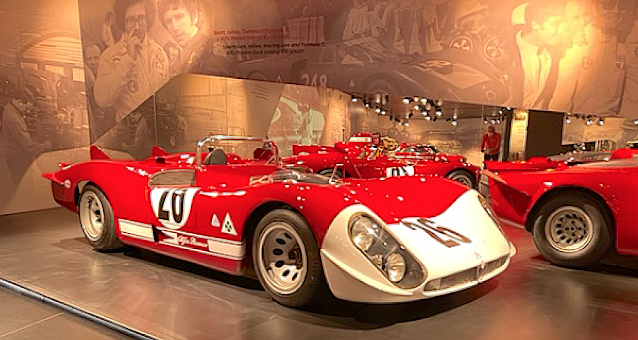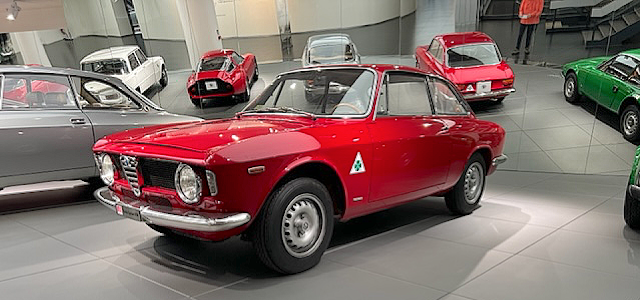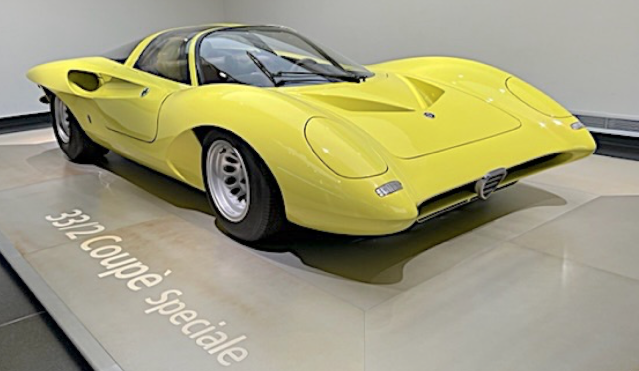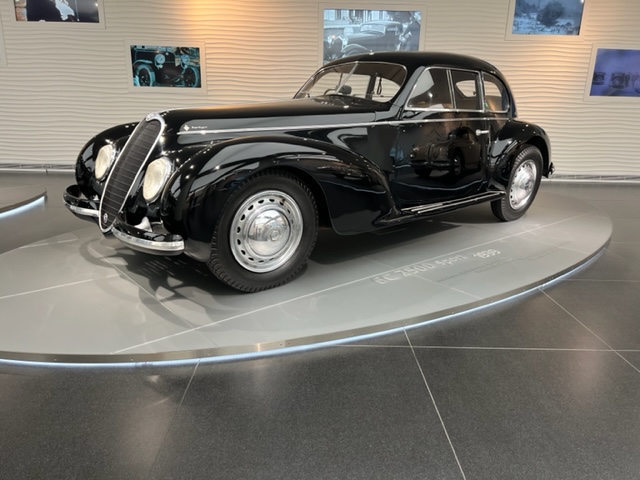By the late Sixties, a new era was beginning at Alfa Romeo, marked by the arrival of mid-engined, V8-powered competition cars, and also by the design of new engines and chassis that would see the company through the Seventies. The T33/2 above is one of the compettion cars. By the time Alfa's Autodelta racing arm modified Carlo Chiti's T33 design for the 1968 endurance racing season, the 2 liter, 4-cam V8 was sending 270 hp through a 6-speed transaxle. A 2.5 liter version made 315 hp, and helped Alfa to finish 3rd in the Manufacturer's Championship in 1968......a year in which Daytona Coupe versions of the 2-liter V8 T33/2 finished 5th, 6th and 7th at the Daytona 24 hours. The first 3 places were taken by 2.2 liter Porsche 907 flat 8s, and 4th was a Shelby Mustang.
A year later, the GT Am replaced the alloy-bodied GTA. Due to an increase in the minimum allowable weight for production-based road racers, the GT Am featured a steel body with some fiberglass, as well as alloy, panels. The 2-liter, twin-cam, twin-plug engine eventually made 240 hp, just 30 hp less than the first Type 33 V8. The chassis on the GT-Am was still based on the live-axle GTV. As with the Type 33 / 2, the GT Am was built by Autodelta; production numbers are the subject of debate.
The Junior Z also appeared in 1969, and was bodied in steel by Zagato to Ercole Spada's design on a Duetto chassis shortened behind the rear wheels to allow for the small overhang on the original 1300 cc model, which stayed in production until 1972, and overlapped the 1600 cc version, with longer rear overhang,and a longer rear hatch (which, like that on the 1300, could be electrically opened for ventilation) that was produced into 1973. The last new Junior Z was sold in 1975. Slightly over 1,500 were built, of which 402 were the 1600 model, and despite their nimble, focused handling and cutting-edge design, the Junior Zs were not quite the last word in exotic variations on the Giulia chassis...
That honor would fall to the Bertone-bodied Montreal, which in 1970 married the Series 105 Giulia chassis with a 2.6 liter production version of the aluminum Type 33 V8. Like the endurance racers, it featured a dry sump, but shared chain-drive for its 4 cams with the T33 Stradale*, unlike the gear-driven racer's cams. Another divergence from the T33 Stradale and racers was that the Montreal featured a cross-plane crankshaft. The body design, penned by Marcello Gandini, was based upon a concept car that had appeared at Expo 67 in Montreal; thus the name. Alfa surprised critics by retaining the tried and true live axle of the Series 105, even though they were working on a new front engine, rear transaxle chassis for ideal weight distribution.
In 1972, Alfa Romeo released its new Alfetta, a 5-passenger sedan with unit body designed by Alfa's Centro Stile and a rear-mounted 5-speed transmission and clutch assembly in unit with the De Dion rear axle. In this configuration the new car echoed its namesake, the Type 159 Alfetta that had won the GP World Championship in 1951. For those who wondered why Alfa had not reserved this chassis for the recent Montreal or the GTV, Alfa released a new Giugiaro-designed fastback Alfetta GTV with the transaxle in 1974, still with the trusty twin-cam Giulia four. And while the V8 Montreal was discontinued in 1977, Alfisti would wait until 1980 to get their hands on the GTV6, uniting the transaxle chassis with a new 60 degree, 2.5 liter SOHC V6 from the Alfa 6 luxury sedan.
Alfa's T33 was actually a series of cars featuring different engine and chassis designs, beginning with a 2 liter, tubular chassis V8, continuing with a 3 liter V8, then a 3 liter flat 12, still with the tubular chassis, and concluding with a twin-turbo 2.1 liter flat 12 with monocoque chassis when the tubular chassis began to flex under the torque load imposed by ever-more powerful engines. The TT12 (TT for Telaio Tubolare, a tubular chassis) appeared in 1972 and after teething troubles, won its first race at Monza in 1974, the model year of the car above, which made 500 hp from 3 liters and weighed only 1,477 pounds. In 1975 a turbo version of the TT12 was introduced, eventually making up to 640 hp in the 1977 version below and requiring a monocoque chassis, indicated by the SC suffix. The 1974 car above helped win Alfa the World Championship of Makes in 1975; in 1977 Alfa's Autodelta team repeated the Championship win in endurance racing, and then shifted its attention to Formula 1.
The normally-aspirated version of the flat 12 from 1975's Championship appears below...
The Gordon Murray-designed 1978 Brabham BT45 below relaunched Alfa's Formula One efforts after the 2 endurance racing championships with the T33, and used a similar design for its flat 12 engine, though with some modification as the engine block was a load-bearing element in the Brabham. Despite the engine's weight penalty compared to Mario Andretti's 1978 Championship-winning Cosworth Ford (in a Lotus), Nicki Lauda won 2 races that year. The first, the GP of Sweden, later resulted in a protest of the ground-effects fan on the BT45, but race officials deemed it to be legal, and Lauda's victory stood. Lauda later won a non-Championship F1 race at Imola in the Alfa-powered Brabham.
Alfa's campaigned a new Type 182 racer with limited success in most of 1982's F1 races. Engineers changed to a 3 liter V12 engine making 540 hp in a new carbon fiber chassis; the combination gained one pole position over the year, but no points...
This front-drive Alfa 164 with transverse 3.0 liter V6 shared a basic chassis design with the Fiat Chroma, Lancia Thema, and Saab 9000, but featured completely distinct body styling by Pininfarina's designer Enrico Fumia. Engine choices also included the Twin Spark inline four, a turobocharged 2 liter V6, and a 24 valve version of the 3 liter V6. The 164 was introduced in 1987, and continued through the Fiat takeover in 1991 into 1997. It was sold in the US through Alfa's temporary departure from our market in 1995. A version with power to all four wheels was offered in Europe, along with diesel versions.
Designer Walter de Silva's team at Alfa Centro Stile created the Nuvola concept car in 1996. It used a twin-turbocharged version of the 2.5 liter V6, but unlike the contemporary Alfa Spider (1993-2004) and GTV ('94-2004) which used the 164's transverse engine and front drive, the Nuvola channeled its 300 hp to all four wheels from an longitudinal engine mounted beneath that long hood. Plastic bodywork convered a tubular steel chassis, and part of Alfa's concept was to revive the coachbuilding art by offering the chassis to specialists like Pininfarina, Bertone and Zagato.
The grille design seemed a reference to Fifties designs from Touring* and Bertone*, and Nuvola, meaning "cloud" in Italian, also recalled Alfa driver Tazio Nuvolari. But the Nuvola, like a cloud, drifted away from production plans as the Nineties shaded into the 21st century.
The 156 sedan did make it into production in 1997, though, and was lighter and more compact than the 164 which it overlapped in production for a year. It was also offered in Sportwagon and Crosswagon versions, the latter with four-wheel drive, and a variety of transverse engines including Twin Spark inline fours in 3 sizes from 1.6 to 2.0 liters, 2.5 and 3.2 liter versions of the V6, and diesels with 4 or 5 cylinders. The car was successful in Europe, and stayed in production through 2007, but was never imported into the US, where it might have offered an alternative to the Audi line.
When it appeared at the Frankfurt Show in 2003, the Alfa 8C Competizione show car reminded critics of Sixties Alfa designs by Zagato and Bertone, but if was designed in house by Wolfgang Eggers. And despite the name, it wasn't a competition car; instead it was designed as a comfortable, high-performance GT. It took awhile for the Fiat combine to get the car into production, and the first of 500 customer cars appeared in 2007 with carbon fiber bodywork on a steel chassis. The front-engine, rear-drive chassis echoied Alfas of the classic period, and 444 hp was provided by a 4.7 liter V8 shared with Maserati and Ferrari. A six-speed manual was the only transmission.
With just under 3,500 pounds of mass sitting on a 104 inch wheelbase, the 8C did not share the lightness or compactness of its Sixties forbears, but it offered plenty of performance and style. An 8C Spider appeared in 2008. Overlapping production of the coupe, which ended in 2009, the Spider was made in 500 units into 2010. It did have another link to Alfa's legendary classics: like the bodies for the Type 33 Stradale*, the prototype for the 8C Spider was built by Carrozzeria Marazzi...
*Footnote:
Touring-bodied Alfas were profiled in Parts 1 and 2 of this series, posted May 8 and May 19, 2022. Bertone-bodied cars are reviewed in Part 2, along with Scaglione's design for the T33 Stradale. The history of Zagato-bodied Alfas was summarized in a photo essay entitled "Body by Zagato Part 2: Five Decades of Alfa Romeos", posted May 6, 2020.
Photo Credits:
All photos were generously provided by George Havelka, except for the front closeup of the Nuvola, which is from Alfa Romeo, and was posed on Wikimedia.






























































